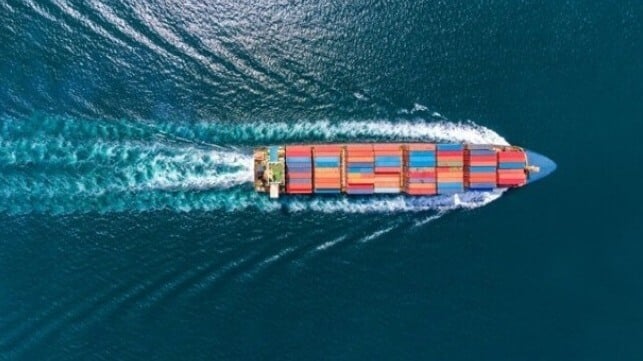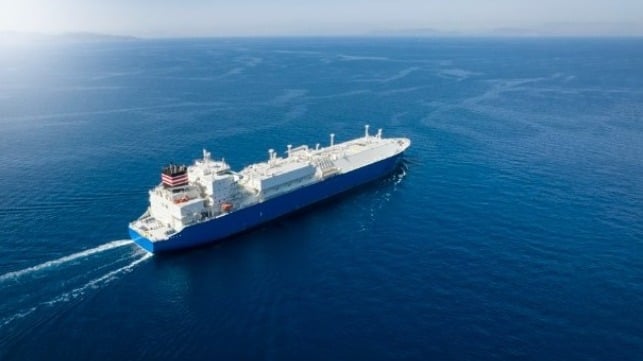UK Launches Maritime Strategy with Emission Pricing and Fuel Regulations

The UK’s Maritime Minister, Mike Kane, outlined a new detailed plan for the next stages of the efforts toward maritime decarbonization. While the policy presented to the House of Commons in Parliament builds off the efforts of the International Maritime Organization, it also launches a focus on smaller vessels and targeted subsectors which it says must also participate to reach the goals.
The policy highlights that the UK domestic maritime sector produced around eight million tonnes of CO2 equivalents, on a full lifecycle basis, in 2019. The government has already launched a sweeping Plan for Change and now it looks to bring more parts of the maritime sector in line with the broader policies. Following the IMO’s lead, the UK is setting its goal for the domestic maritime sector aiming for zero fuel lifecycle GHG emissions by 2050. The interim steps are at least a 30 percent reduction by 2030 and an 80 percent reduction by 2040, relative to 2008 levels.
The elements of the strategy call for expanding the UK’s Emission Trading Scheme to include domestic UK maritime GHG emissions starting in 2026. At the same time, the UK says it will advocate at the IMO for the introduction in 2027 of global emission pricing. As part of this, the government says subject to further consultation next year, it will introduce domestic fuel regulations to drive the update of zero and net-zero GHG emission fuels and energy sources. It will also consider further actions at the port vessel to reduce at berth emissions.
The UK also looks to expand its policies to smaller vessels, i.e. sub-400 gross tons. It points out that it will be difficult for some sectors such as fishing vessels while others such as offshore wind support vessels could lead the sector. The government is issuing a call for evidence to begin this policy development.
The government will also launch a further exploration of the efforts at the port level. It will look at whether ports are planning decarbonization and the strategies for wider environmental considerations.
While recognizing that the efforts will be challenging for the sector, the government also cites opportunities for investment and creating new economic opportunities. They note that conservative estimates show that decarbonization of the UK maritime sector could support £130 to £180 million (US$168 to $233 million) of gross value added and around 1,400 to 2,100 jobs in the UK on average each year to 2050.
The UK Chamber of Shipping hailed the release of the new strategy saying it welcomed the Government’s publication of the Maritime Decarbonization Strategy, as a much-needed successor to the 2019 Clean Maritime Plan.
“The Government’s strategy must now be matched by delivering the regulatory framework, technology and infrastructure, including a shore power revolution, required to support the green transition for UK maritime, bringing benefits to maritime communities and the UK economy,” said UK Chamber CEO Rhett Hatcher. “We look forward to working collaboratively alongside government to progress this important agenda and reach our shared goals of a cleaner, more resilient maritime sector in the UK.”
Op-Ed: FuelEU Maritime Has Teeth, But is the Industry Equipped to Meet It?

 The introduction of FuelEU Maritime (FEUM) in January 2025 represents one of the most comprehensive pieces of regulation designed to directly mitigate the carbon intensity of maritime operations. Working in tandem with the EU’s existing ETS regulation, FEUM comes with significant penalties for non-compliance and has the ability to make a tangible impact on the maritime industry’s carbon emissions while incentivizing the acceleration in low-carbon alternative fuel development.
The introduction of FuelEU Maritime (FEUM) in January 2025 represents one of the most comprehensive pieces of regulation designed to directly mitigate the carbon intensity of maritime operations. Working in tandem with the EU’s existing ETS regulation, FEUM comes with significant penalties for non-compliance and has the ability to make a tangible impact on the maritime industry’s carbon emissions while incentivizing the acceleration in low-carbon alternative fuel development.
As of January 2025, vessels are required to decrease the average greenhouse gas intensity of their fuel use by 2% relative to the industry average for vessels above 5,000 GT. This requirement will continue to increase gradually over the coming years to reach an 80% decrease by 2050.
The regulation also imposes detailed reporting obligations, which require companies to monitor and report the lifecycle GHG intensity of their fuel mix. This data must be verified by an accredited third party and submitted to the FEUM database, creating a further layer of administrative complexity to ensure compliance.
Ultimately, the goal of FEUM is to promote the increased use of low-carbon alternative fuels as a means of drastically curtailing the industry’s carbon emissions in order to achieve the IMO’s GHG reduction strategy. However, the industry is still faced with significant challenges when it comes to establishing alternative fuel viability at scale. Biofuels currently lack the required feedstocks needed to promote development, fuel technologies such as methanol and ammonia bring with them a significant risk profile due to their volatile composition, and the increase in e-fuel development is hampered by the lack of onshore infrastructure to support the necessary supply of green electricity. Furthermore, the CAPEX implications, not just of the fuels themselves, but in committing to retrofit and newbuild development to future-proof the global fleet, represents a significant barrier.
Despite these challenges, Bureau Veritas (BV) remains steadfast in its efforts to support the safe development and integration of alternative fuels into maritime operations. With longstanding expertise in supporting the development of viable alternative fuels, particularly within Liquefied Natural Gas (LNG) bunkering vessels, BV has been developing rules and guidelines for LNG bunkering and has awarded AiPs of ship designs dedicated to ship-to-ship bunkering since 2012. To enhance safety, BV introduced the Rule for LNG Bunkering Ships, which focused on a transfer system to prevent leaks and boil-off gas handling systems for ships that aren’t sailing continuously but waiting for fuel delivery. Today, BV covers all units in the LNG segment, having classified around 35% of the world’s bunkering ships in service and 50% of the orderbook to date.
Whilst LNG remains an important part of the current energy landscape, the development of greener alternatives – such as ammonia, methanol, and green hydrogen – are vital to establishing a robust, multifuel environment. Using our experience in LNG, BV has developed Rules (NR671) and notations to support the adoption of ammonia as a fuel onboard, whilst having recently announced that it would be classifying the first of four newbuild dual-fuel methanol chemical IMO II medium-range (MR) tankers, built at Guangzhou Shipyard International for owner Socatra and its joint-venture partner Hafnia.
However, despite the significant emissions reductions that can be unlocked by the delivery of viable and scalable alternative fuel options, if shipping is to achieve its interim emissions targets in 2030 and 2040, all energy efficiency and wider green technologies must be engaged in order to decarbonize the global fleet. FEUM has adopted a technology-agnostic approach to achieving compliance that provides the flexibility for shipowners and operators to engage with a variety of green solutions that support emissions reductions. These solutions focus particularly on fuel cells, onboard electrical energy storage, as well as onboard power generation from wind and solar energy.
When considering the use of wind propulsion systems (WPS), FEUM represents the only emissions regulation to include a specific reward mechanism to promote the use of WPS. The Wind Reward Factor (WRF) offers up to a 5% reduction on the GHG calculation of energy used onboard for those vessels where wind assisted propulsion accounts for 15% or more of the propulsive power used onboard.
As of February 2025, more than 125 wind propulsion systems have been installed on over 57 ships, in addition to 17 ships that are already prepared for potential installation of wind propulsion systems. In fact, a recent study suggested that over 1,600 ships will be ordered by 2030, and by 2050, it is estimated that 30% of the entire global fleet will have engaged with wind propulsion technology. These statistics make clear that, while the industry grapples to develop alternative low-carbon fuel viability, wind propulsion systems provide a proven and readily available solution that can make a significant impact on owners' and operators' compliance efforts.
Furthermore, BV’s own modeling has confirmed the potential cumulative impact that operational and technical efficiency measures will make to ensuring shipping stays within its “GHG budget” to 2050. BV’s simulations, outlined in its decarbonization trajectories technical paper, show that without action to reduce speed or waiting time while ocean transportation volumes grow moderately to reach a 50% increase by 2050, GHG emissions would be 92% higher in 2050, with 44% more emissions over the period from a GHG budget perspective, than if these levers had been actioned.
As we edge closer to the IMO’s 2030 checkpoint, which will require the industry to evidence a GHG emissions reduction of at least 20 – and striving for 30% – the pressure on the industry to make meaningful impacts on their carbon emissions continues to increase. The introduction of new regional regulation is having a positive impact on reducing shipping’s carbon emissions. However, such regulation will always be subject to dynamic carbon credit prices, a volatile political landscape, and the emergence of compliance incentives and mechanisms that may inhibit or support their efficacy.
Meanwhile, the industry is waiting for the upcoming IMO MEPC83 meeting in April, where mid-term measures, including a potential codified global carbon levy, are expected to be announced. If the levy introduced is sufficiently robust, such a measure holds great promise for the next phase in the industry’s decarbonization efforts. If effective, a global carbon levy could provide a level of financial certainty to incentivize further investment in low-carbon fuel production, narrow the price gap between fossil and alternative fuels, and generate the revenue required to achieve sector-wide low-carbon fuel viability.
Suba Sivandran is Director of Strategy, M&A and Advanced Services at BV.
The opinions expressed herein are the author's and not necessarily those of The Maritime Executive.
No comments:
Post a Comment